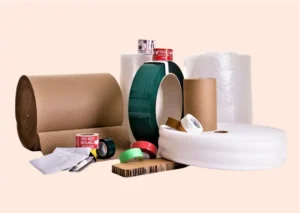Table of Contents
- 1 What is Moving Insurance and Why is it Necessary?
- 2 Explaining the Different Types of Moving Insurance Coverage
- 3 How to Determine the Cost of Moving Insurance
- 4 Ensuring the Safety of Your Possessions
- 5 Is Your Mover’s Insurance Enough?
- 6 Extra Coverage Choices for Assurance
- 7 Protecting Your Move: Before, During, and After
- 8 Common Questions About Moving Insurance
- 9 Author

Summary
-
It’s important to have moving insurance to safeguard your items during transit.
-
There are two primary types of moving insurance: Released Value Protection and Full Value Protection.
-
To calculate the cost of moving insurance, you’ll need to determine the value of your items and select the appropriate coverage.
-
Packing your items carefully and maintaining a detailed inventory list are critical steps to ensuring the safety of your move.
-
Reach out to us for assistance in finding the most suitable insurance solution for your needs.
What is Moving Insurance and Why is it Necessary?
Moving to a new home can be thrilling, but it’s also a time when your items are at their most vulnerable. That’s why moving insurance exists. It’s designed to protect your items from damage or loss during the move. But is it necessary? Definitely. Think of it as a safety net for your valuables during one of life’s major changes.
Getting to Know the Fundamentals of Moving Insurance
Consider this scenario: You’ve packed up your grandmother’s antique china set, only to discover it shattered upon arrival. With moving insurance, you could receive reimbursement for this loss. Moving insurance, also known as valuation coverage, is available in various types and provides different degrees of protection for your belongings while they are being transported, stored, or handled by movers.
Deciding Whether You Need Coverage
Before you decide to forgo moving insurance, think about how much your belongings are worth. If something were to happen, could you afford to replace them? If not, then insurance is a smart choice. More than anything, it gives you peace of mind, knowing that you’re protected.

Explaining the Different Types of Moving Insurance Coverage
Next, we’ll go over the different types of moving insurance to help you determine which one is right for you.
What Released Value Protection Covers
Released Value Protection is the most basic coverage, often included at no additional cost. However, it offers minimal protection—usually just cents on the dollar for the weight of the item, not its actual value. For example, if your 10-pound speaker worth $300 gets damaged, you might only receive $6 in compensation.
Full Value Protection: All-Inclusive Insurance
For those seeking all-inclusive coverage, Full Value Protection is the best choice. Though it’s pricier, it guarantees that if any of your items get damaged or lost, they will be fixed, replaced, or a cash settlement will be given to you that equals the current market replacement value, no matter how much the original purchase price was.
-
The total weight of your belongings is taken into account.
-
You will need to state how much your items are worth.
-
There may be a deductible that could change the final price.
Given these factors, Full Value Protection provides a better security blanket for your items.
Third-Party Insurance: When You Might Need It
Third-party insurance can be a good option if you’re moving items that have a high value, such as heirlooms or collectibles. This is because moving companies often limit the amount they’ll pay for these types of items, so third-party insurance can provide additional coverage.
How to Determine the Cost of Moving Insurance
When you’re trying to figure out how much moving insurance will cost, you’ll need to start by figuring out how much all of your stuff is worth. Here’s a step-by-step guide to help you figure out how much it will cost:
How to Calculate Your Moving Insurance Costs
Start by making a list of everything you’re moving. Then, figure out how much each item is worth. You may need to do some research to get accurate numbers, but it’s important for getting the right amount of coverage. Finally, choose the kind of insurance that fits your needs. Keep in mind that more coverage will cost more, but it will also protect you more.
Why Inventory Matters When Determining Insurance Value
It’s crucial to maintain a comprehensive inventory. Not only does it assist in determining the cost of insurance, but it also makes the claims process easier if anything goes wrong. Be as detailed as possible—brand names, model numbers, and the condition of items all matter.
With this information in hand, you’re now in a position to make an informed decision about moving insurance. Remember, our team is here to guide you through the process and provide tailored solutions. Don’t hesitate to Contact Us for personalized advice on how to best protect your belongings during your move.

|
Insurance Company |
Cost Details |
|---|---|
|
Tivly |
Offers general liability coverage for moving companies. Cost details not provided. |
|
Relocation Insurance Group |
Provides storage insurance and covers several perils. Available in all 50 states. Cost details not provided. |
|
Baker International |
Specializes in comprehensive insurance coverage for household moves and corporate relocations. Offers full coverage policies and efficient claims processing. Cost details not provided. |
|
Lakeland Insurance |
Offers claims resolution services. Specific cost information not available. |
|
UNIRISC |
Best for international moves. Cost details not provided. |
The cost for moving insurance from a third-party insurer may be between 1% and 5% of your valuation estimate.For example, if the total value of your belongings is estimated at $18,000, the moving insurance cost would be between $180 and $900.
Ensuring the Safety of Your Possessions
Safeguarding your possessions isn’t just about choosing the best insurance policy. It’s also about taking steps to reduce the chance of harm. Let’s look at how you can enhance the security of your belongings even before the moving process starts.
How to Pack to Minimize Damage
Start by buying good packing materials. You’ll need strong boxes, bubble wrap, and packing peanuts. Put heavy things in small boxes so they don’t break, and put lighter things in bigger boxes. Write on each box to say what’s in it and what room it should go in. This will help you stay organized and will also help if you need to make a claim.
How to Keep an Inventory List: Tips and Tricks
If you need to file a claim, a thorough inventory list is a critical document. Here’s how to make one that works:
-
Take a picture of each item and write a description.
-
Write down the serial numbers for any electronics or appliances.
-
Keep a hold of any receipts or appraisals for items that are worth a lot of money.
Keeping a detailed inventory means you have all the necessary information on hand, which makes it easier to prove how much your items are worth if you need to.
Is Your Mover’s Insurance Enough?
It may be tempting to rely solely on the insurance provided by your moving company. However, keep in mind that this insurance may not fully cover the cost of your belongings. Most moving companies provide basic coverage, but you may need to purchase additional insurance to ensure you’re fully protected.
-
Released Value Protection usually offers limited compensation based on the weight of the item.
-
Full Value Protection might provide repair, replacement, or cash settlement.
-
Third-Party Insurance can fill in the gaps left by the mover’s policy, particularly for items of high value.
Considering these options, you might decide that getting extra coverage through a third-party insurance provider or improving the mover’s policy with additional protection is the most effective way to make sure your items are fully covered.
Assessing Your Moving Company’s Insurance Choices
Be sure to question your movers about the insurance policies they offer. Find out what the process for making a claim is, how long you have to file one, and if there are any deductibles. Knowing this information ahead of time can prevent unpleasant surprises down the road.
What You Should Ask Your Mover About Insurance
When you talk to your mover about insurance, you might want to ask these questions. It’s also helpful to read up on efficient strategies for a stress-free move, which can provide additional insights into what to expect and how to prepare for moving day.
-
What kind of protection does my moving package offer?
-
How is the worth of lost or broken items determined?
-
What steps do I need to take to file a claim, and what paperwork is required?
These questions can help you understand what kind of coverage you already have and what else you may need to do to make sure you’re fully covered for your move.

Extra Coverage Choices for Assurance
When it comes to things like family heirlooms, art, or high-tech devices, regular moving insurance might not be enough. This is where third-party insurance or supplemental policies come in, providing the additional protection you require.
Especially if you have items that can’t be replaced or are worth more than the coverage limits of regular moving insurance, it’s a good idea to consider these options.
Extra Coverage for Priceless Possessions
If you have items of high value, like antiques or fine art, you might want to think about extra coverage. This additional insurance can be customized to the value of these particular items, making sure their entire value is covered.
These types of policies typically require you to provide appraisals or detailed receipts, so you should be ready to offer paperwork that verifies the value of your belongings.
Deciphering the Small Text in Insurance Agreements
It’s vital to carefully read and comprehend the terms and conditions of any insurance agreement. Be sure to pay special attention to:
-
Exclusions: What items or situations aren’t included in the coverage?
-
Limits: Is there a maximum coverage amount for individual items or the total claim?
-
Deductibles: What amount will you be required to pay out-of-pocket before the insurance starts to cover?
Having a clear understanding of these details will help you to avoid unexpected surprises during the claims process and ensure that your coverage is what you expect it to be.

Protecting Your Move: Before, During, and After
Obtaining moving insurance is just one aspect of protecting your move. Here are some other measures to take before, during, and after the move to ensure a smooth transition and peace of mind.
Insurance Preparedness Checklist Before Moving
Before you embark on your moving journey, it’s crucial to ensure you have the right insurance coverage to protect your belongings during the move.
Before you even pack a box, there’s a checklist you should follow to ensure you’re insurance-ready:
-
Check your existing homeowners or renters insurance to see if it includes moving coverage.
-
Obtain quotes from multiple insurance companies and compare their policies.
-
Create a comprehensive inventory of your belongings, including their estimated value.
-
Determine the amount of insurance coverage you need based on your inventory.
-
Select between Full Value Protection and Released Value Protection.
-
Think about getting extra insurance for high-value items.
Completing these steps will prepare you for a well-insured move.
On the Day of Your Move: Making Sure You’re Following Your Insurance Plan
On moving day, you’ll want to make sure everything goes as planned:
-
Make sure the movers have a copy of your inventory list and that they have their own copy.
-
Document the loading process by taking photos or videos of your items.
-
Keep all insurance documents and contact information at hand.
-
Ensure that the moving company adheres to your packing instructions.
By being alert, you can ensure that your belongings are handled correctly and that you are complying with the terms of your insurance policy.
What to do After Moving: Resolving Claims and Disputes
Once you’ve moved, be sure to check your belongings right away. If anything is damaged, here’s what you should do:
-
Take pictures or record a video of the damage.
-
Immediately contact the moving company to report the damage.
-
Check your inventory list and insurance policy to begin the claims process.
-
Submit a claim to the moving company or your insurance provider as necessary.
Acting quickly and providing detailed information after your move can help make the claims process easier.

Common Questions About Moving Insurance
What Are Some Items That Moving Insurance Usually Doesn’t Cover?
It’s important to note that most moving insurance policies do not cover everything. Some common items that are not typically covered include:
-
Things that can spoil
-
Plant life
-
Dangerous substances
-
Belongings packed by you
Make sure you always look over your policy for any specific items that aren’t covered.
Is It Possible to Buy Moving Insurance After the Move Has Begun?
It’s a good idea to get moving insurance ahead of time. That said, some providers may let you purchase insurance once the move is already underway, but the coverage may not be as comprehensive.
How Does Your Deductible Impact Your Moving Insurance?
A deductible refers to the amount you must pay before your insurance begins to cover the rest. If you opt for a higher deductible, you can expect a lower premium, but this also means that you will have to pay more if you file a claim.
Does Personal Insurance Cover Do-It-Yourself Moves?
For those who have homeowners or renters insurance, you might find that your policy provides some coverage for do-it-yourself moves. To fully understand what your policy covers, you should review it or get in touch with your insurance agent.
What is the Time Limit to File a Claim After a Move?
The window to submit a claim can differ based on your insurance company, but it’s usually within 9 months of delivery. Make sure to read your policy for the exact time limit and procedure for submitting a claim.




Leave a Reply